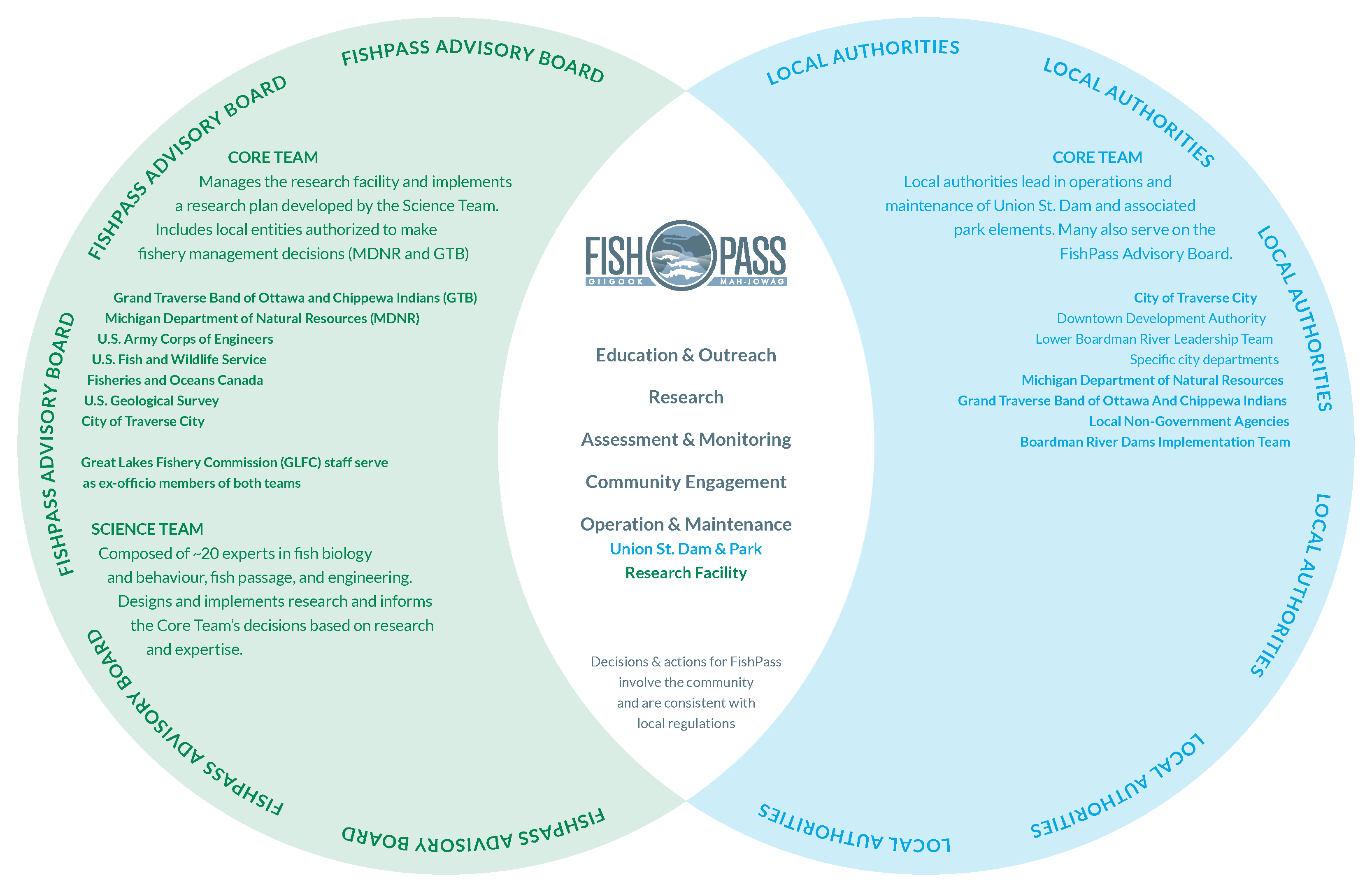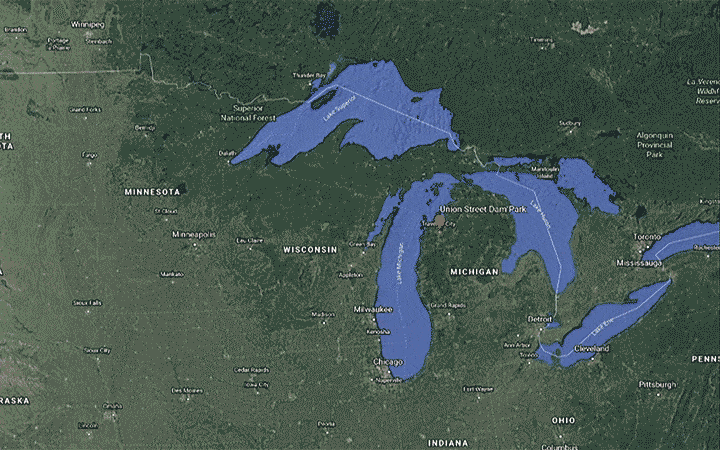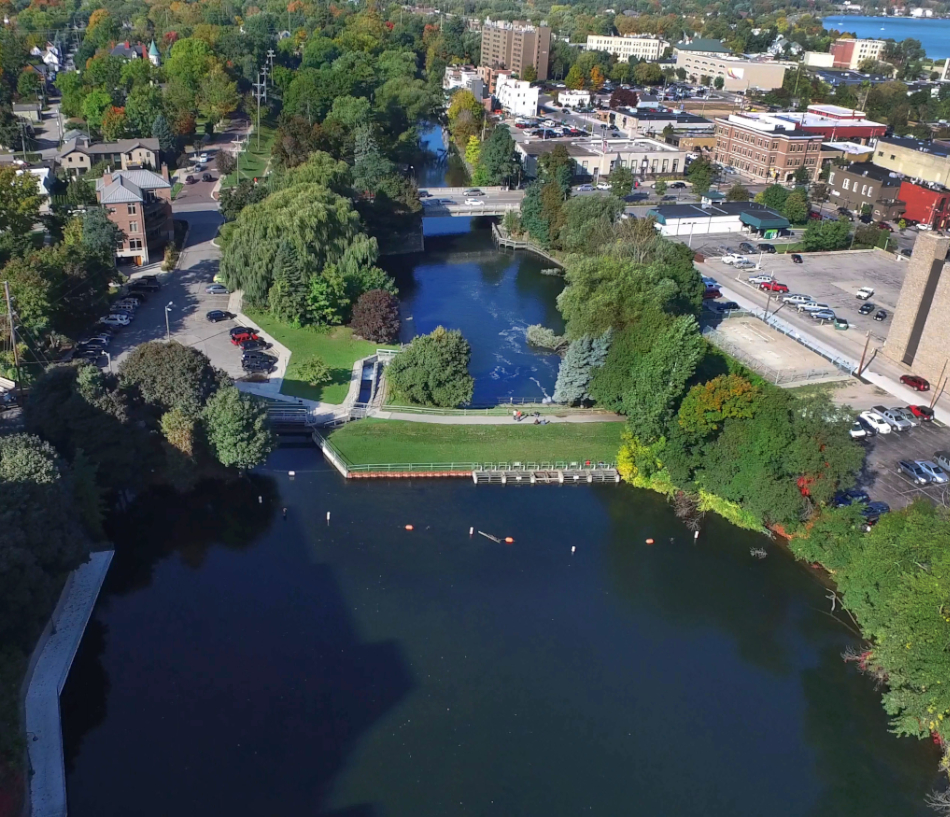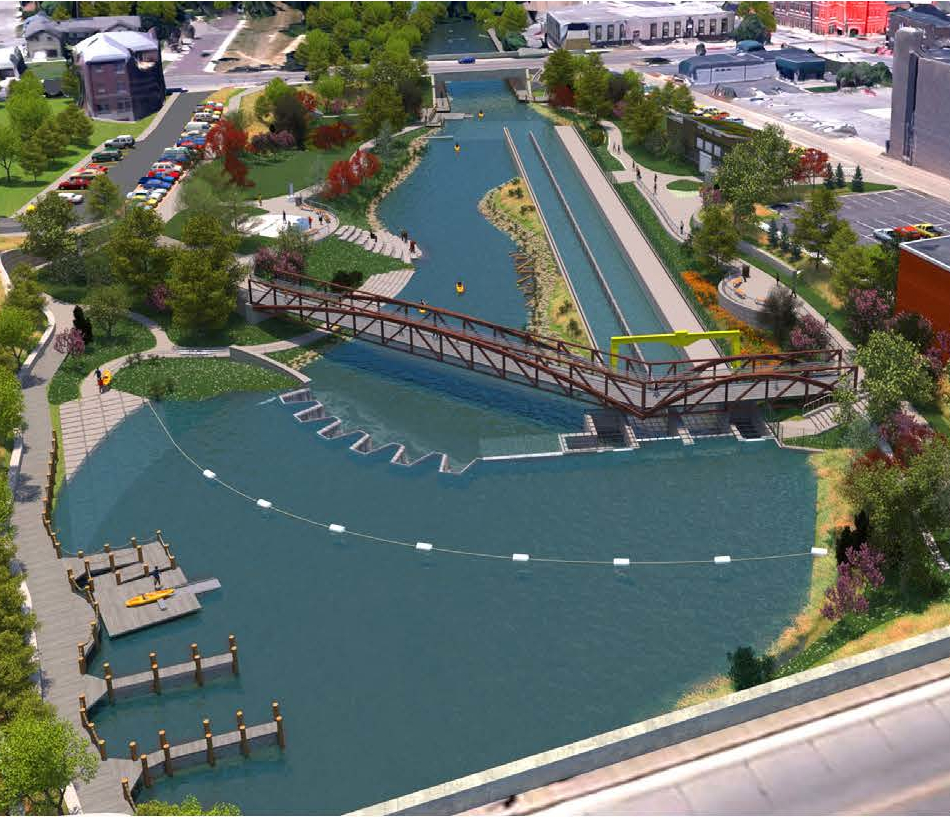What is FishPass?
FishPass is the capstone of a ~20y restoration project on the Boardman (Ottaway) River, Traverse City, Michigan, re-connecting the river with Lake Michigan. FishPass will replace the deteriorating Union Street Dam with a new, complete barrier to all fish that will have the ability to sort and selectively pass desirable fishes while blocking harmful invaders like sea lamprey. While fully automated selective passage is the long-term goal of the project, passage of any fish during the initial 10-yrs will be coordinated with fishery management agencies, limited in number, and restricted to fishes native to the upper Great Lakes.
FishPass encompasses the following three main elements:
- Physical: A 6.5 ft vertical barrier across the entire river, a nature-like river channel, a fish-sorting channel, a research and education building, and a park.
- Research: A place for scientists to use a variety of techniques and technologies to determine the most effective means of sorting desirable and undesirable fishes below a barrier.
- Education: A community outreach and education center in a revitalized city park.
Figure 1. Animated illustration of the condition of the Boardman River and the Union Street Dam before (left) and after (right) construction of FishPass. Use the arrows to scroll between the figures. Note that the "after" condition is an artist rendering and is for illustrative purposes only.
Figure 2. An interactive schematic of the new Union Street Dam and FishPass on the Boardman River. Click the icons to see descriptions of the features or use the arrows at the bottom to scroll through them. The computer model, generated from engineering design plans and landscape details, is intended for illustrative purposes only.
Why FishPass?
The Boardman River Restoration project always envisioned a modification of Union Street Dam that would re-connect the river to Lake Michigan to re-establish hydrological and ecological connectivity without allowing passage of invasive species, like sea lamprey. FishPass provides a unique solution that will also permit desirable fish passage up- and down-stream thereby completing the restoration process.
Who Is FishPass?
FishPass is supported by a group of local, tribal, federal, and state agencies, local non-government organizations (NGOs), and The City of Traverse City. Funding for FishPass comes from the Great Lakes Restoration Initiative, Michigan Department of Natural Resources Dam Management Grant, Great Lakes Fishery Trust, City of Traverse City, and the Great Lakes Fishery Commission. The governance of FishPass is described in the figure below.

Figure 3. Description of the governance of FishPass as well as decision-making and implementation processes and roles and responsibilities of each of the project partners.
The FishPass Advisory Board provides direction and leadership surrounding research, measurement of project success, funding, community involvement, general operation, decision-making, and regulation over the 10-year span of the project and beyond (see Figure 3).
Local authorities own, operate, and maintain the dam and community park and city property upon which FishPass resides. The support and involvement of local authorities is essential, as many local and environmental regulations must be considered during the decision-making process (see Figure 3). Every element of FishPass to date has involved the collaboration and support from the community alongside the guidance and leadership of the Traverse City Commission and the FishPass Advisory Board.
You can find a record of community engagement in FishPass here.
Where Is FishPass?

Figure 4. Traverse City and the Union Street Dam is located in Michigan’s lower peninsula on the northeastern shores of Lake Michigan and is the location of the new dam structure and FishPass.
When Will FishPass Be Built?
FishPass construction is anticipated to start in 2024.
See the final stamped and signed engineering plans and specifications.
View the monthly FishPass update.
FishPass Guiding Principles
The FishPass Project Overview defines project goals organized according to core aesthetic, biological, economic, recreational, and social elements of the project. These goals serve as a framework for evaluating project success and functional project values. However, to ensure that scientific research at FishPass is transparent and accountable, it is necessary to also define the core values and principles that will guide the research and outreach and communication associated with that research. See more details in the FishPass Guiding Principles.
FishPass Documentation
All FishPass documents are considered live and will be periodically updated as FishPass evolves over time.
- Detailed FishPass Project Overview - provides a detailed overview of the project, objectives, history, evolution, and expected outcomes
- FishPass Research Plan - provides a conceptual framework of selective fish passage to be implemented at FishPass and outlines the phases of research to achieve the project mission and objectives
- FishPass Research Model - provides an outline for how research studies will be requested, selected, and implemented at FishPass.
- FishPass Assessment Plan - provides a description of the monitoring and assessment techniques currently being employed to address FishPass objectives and achieve the biological goals of the project
- FishPass Site Selection - provides a description of the site selection process for the project
- FishPass Supplemental Research Project Summaries - provides a brief summary of completed and ongoing research supporting development of selective fish sorting operations and collection of baseline data supporting adaptive management of future FishPass operations and evaluation of project efficacy
Identifying desirable species for passage
Public consultations led by Michigan Department of Natural Resources and Grand Traverse Band of Ottawa and Chippewa Indians will identify "desirable" species thereby prioritizing needs for passage.
The Michigan Department of Natural Resources commit to no salmon or steelhead passage for 10 years following FishPass construction.
The Grand Traverse Band of Ottawa and Chippewa Indians supports bi-directional fish passage across man-made barriers of only fish species native to the Lake Huron, Michigan, and Superior basins.
Find the Answers to Your Questions Here!
Most Frequently Asked Questions & Answers
Can't find your question?
Expansive list of questions with answers
You may also contact the principle engineer and scientist for FishPass below:
- Dr. Daniel Zielinski
- Stationed in Traverse City, MI
- 231-421-1834
- [email protected]
Above is three-dimensional animated virtual tour of FishPass. The computer model, generated from engineering design plans and landscape details, is intended for illustrative purposes only. The model does not accurately depict existing trees slated for preservation (see landscape rendering above for more details). The site is also populated with people and kayakers to demonstrate future uses of the site.



